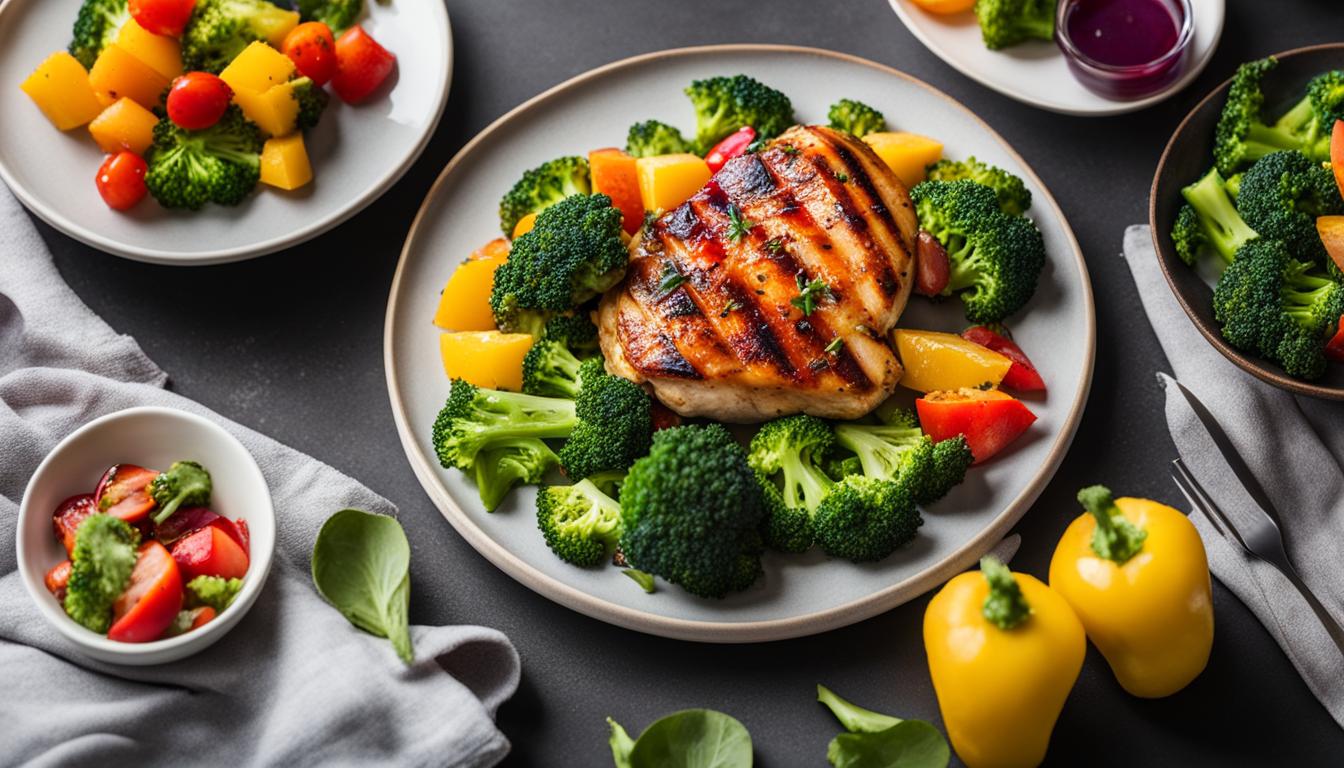Welcome to my comprehensive guide on how to optimize your health through fat-burning meal plans and workouts. Are you ready to embark on a journey towards achieving your weight loss goals? By incorporating effective meal plans and targeted workouts into your routine, you can supercharge your metabolism, burn calories, and improve your overall fitness. In this article, I will provide you with valuable insights, tips, and strategies for creating and following fat-burning meal plans and workouts, all designed to help you reach your desired level of health and fitness.
Key Takeaways:
- Proper nutrition is essential for fat-burning and weight loss
- High-intensity interval training (HIIT) can be an effective workout plan for fat-burning
- Clean eating, focusing on wholesome foods, is a foundation for fat-burning
- A customizable two-week meal plan can support your fat-burning goals
- The Mayo Clinic Diet offers a comprehensive approach to weight loss and long-term weight management
The Importance of Nutrition in Fat-Burning
Nutrition plays a vital role in the process of fat-burning and weight loss. The food we consume not only provides energy for workouts but also has a significant impact on our metabolism and fat-burning potential. By following well-balanced meal plans that incorporate lean proteins, healthy fats, and complex carbohydrates, we can properly fuel our bodies and optimize fat-burning. Additionally, reducing calorie intake and avoiding processed foods and sugary snacks can contribute to more effective fat loss.
The Power of Proper Nutrition
Proper nutrition is the foundation of any successful fat-burning journey. By nourishing our bodies with the right nutrients, we can support our metabolism, maintain muscle mass, and enhance fat-burning efficiency. Below are some key aspects of nutrition that are crucial for fat-burning:
- Lean Proteins: Include sources like chicken, fish, beans, and tofu in your meals. Protein boosts metabolism, promotes satiety, and helps preserve muscle mass during weight loss.
- Healthy Fats: Incorporate avocados, nuts, and olive oil into your diet. These fats provide crucial nutrients, support hormone production, and help regulate appetite.
- Complex Carbohydrates: Opt for whole grains, sweet potatoes, and legumes. These carbs provide lasting energy, support workout performance, and regulate blood sugar levels.
- Reduced Calorie Intake: Create a calorie deficit by consuming fewer calories than you burn. Tracking your daily calorie intake can be helpful in supporting fat loss.
- Avoid Processed Foods: Stay away from foods high in added sugars, refined grains, and unhealthy fats. Processed foods can hinder fat-burning and provide empty calories.
“The food you eat can either be the safest and most powerful form of medicine or the slowest form of poison.”
Key Nutrients for Fat-Burning
A well-rounded fat-burning meal plan should include essential nutrients that support overall health and aid in weight loss. Here is a table outlining some key nutrients and their benefits:
| Nutrient | Function | Food Sources |
|---|---|---|
| Protein | Supports muscle growth, repairs tissues, and boosts metabolism | Chicken breast, Greek yogurt, lentils |
| Fiber | Promotes satiety, aids digestion, and helps regulate blood sugar levels | Whole grains, fruits, vegetables |
| Healthy Fats | Aids in nutrient absorption, supports hormone production, and provides long-lasting energy | Avocado, nuts, olive oil |
| Vitamins and Minerals | Support overall health, boost immune function, and aid in energy production | Leafy greens, colorful fruits, lean meats |
| Water | Hydrates the body, supports digestion, and aids in metabolic processes | Plain water, herbal teas, fruits with high water content |
HIIT 100s: An Effective Workout Plan

The HIIT 100s workout plan is a high-intensity interval training program that can greatly contribute to fat-burning. This plan involves progressively decreasing rest time between intervals and simultaneously reducing carbohydrate intake each week.
By following this workout plan, you can challenge your body, increase calorie burning, and promote fat loss. The combination of intense workouts and a controlled carbohydrate intake can lead to significant results in terms of weight loss and overall fitness.
High-intensity interval training (HIIT) involves short bursts of intense exercise followed by brief recovery periods. It is known for its ability to maximize calorie burning and fat loss in a short amount of time. HIIT workouts typically consist of a series of exercises performed at maximum effort for a set amount of time, such as 30 seconds, followed by a short rest period, such as 15 seconds. This pattern of intense effort and recovery is repeated for several rounds, resulting in a highly effective fat-burning workout (check this post out).
The HIIT 100s workout plan takes this concept a step further by progressively decreasing the rest time between intervals. Each week, the rest periods become shorter, allowing for even greater intensity and calorie burning. Additionally, the plan incorporates a gradual reduction in carbohydrate intake to further optimize fat-burning.
By challenging your body with intense intervals and manipulating carbohydrate intake, the HIIT 100s workout plan creates the perfect environment for fat loss. Not only does it increase calorie burning during the workout, but it also has a lasting effect on your metabolism, helping you burn more calories even after the workout is over.
When following the HIIT 100s workout plan, it’s essential to prioritize form and technique to ensure safety and effectiveness. Each exercise should be performed with proper form, and modifications can be made based on individual fitness levels and abilities. It’s also crucial to listen to your body and rest when needed, as high-intensity workouts can be demanding.
So, if you’re looking for an effective fat-burning workout plan, give the HIIT 100s a try (check out my post on fat-burning workout here). With its focus on intense intervals and controlled carbohydrate intake, you can maximize calorie burning, challenge your body, and achieve your fitness goals.
Clean Eating: A Foundation for Fat-Burning
In our quest for optimal health and effective fat-burning, it’s crucial to establish a strong foundation of clean eating. Clean eating is an approach to nutrition that centers around consuming wholesome foods and reducing our intake of processed and additive-laden products. By adopting this clean eating plan, which emphasizes nutrient-dense whole grains, lean proteins, fruits, vegetables, and healthy fats, we can provide our bodies with the essential nutrients they need while avoiding unnecessary additives and preservatives.
Clean eating forms the backbone of a healthy and balanced diet, promoting overall well-being and supporting fat-burning. By incorporating wholesome, unprocessed foods into our meals, we fuel our bodies with vital vitamins, minerals, and antioxidants that are essential for optimal health. These nutrient-dense foods provide us with sustained energy, help regulate our metabolism, and promote proper digestion, all of which play a significant role in our weight management efforts.
One of the key principles of clean eating is to minimize our consumption of processed foods. Processed foods are often high in unhealthy fats, artificial sugars, and sodium, which can negatively impact our health and hinder our fat-burning goals. By prioritizing whole, unprocessed foods, we nourish our bodies with the necessary nutrients while reducing our intake of unhealthy ingredients and additives.
In addition to promoting fat-burning, clean eating also encourages the consumption of healthy fats. Healthy fats, such as those found in avocados, nuts, seeds, and olive oil, are essential for our overall well-being. They provide us with essential fatty acids that support brain function, help reduce inflammation, and aid in nutrient absorption. By incorporating these healthy fats into our meals, we not only enhance the flavor and satiety of our dishes but also support our weight management goals.
Quote: “Clean eating means consuming whole, unprocessed foods that nourish our bodies and promote overall well-being.” – Clean Eating Expert
To help you better understand the concept of clean eating, I have prepared a table with examples of wholesome foods and their nutritious benefits:
| Foods | Nutritional Benefits |
|---|---|
| Fresh fruits and vegetables | Rich in vitamins, minerals, and antioxidants that support overall health and wellness. |
| Lean proteins (chicken, fish, tofu) | Provide essential amino acids for muscle growth and repair, supporting a healthy metabolism. |
| Whole grains (quinoa, brown rice, oats) | High in fiber, vitamins, and minerals, promoting digestive health and sustained energy levels. |
| Healthy fats (avocado, nuts, olive oil) | Supply essential fatty acids, aiding in nutrient absorption and supporting brain function. |
By incorporating these wholesome foods into our daily meals, we nourish our bodies with the essential nutrients needed for fat-burning, weight management, and overall wellness.
Customizable Two-Week Meal Plan
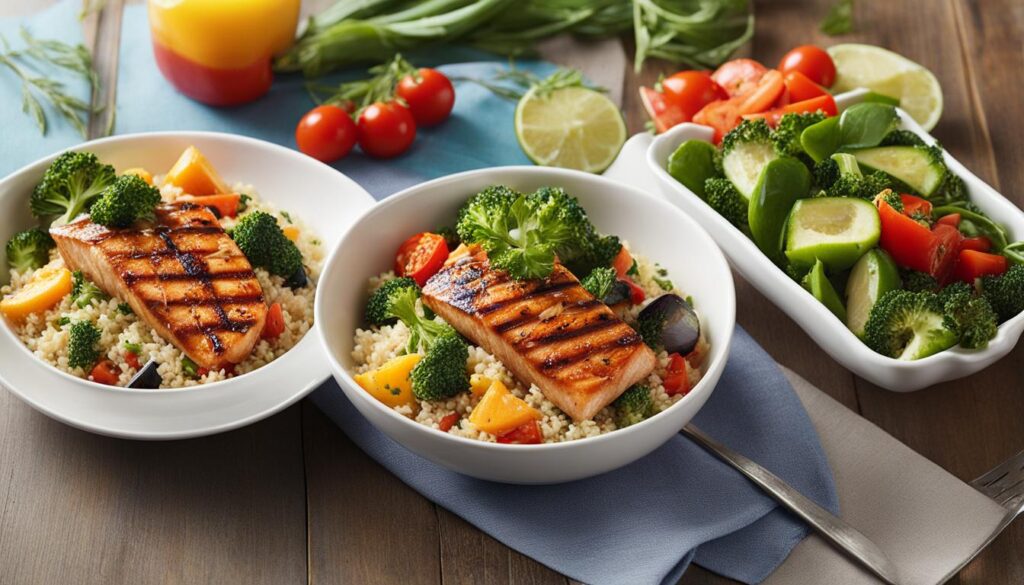
To kickstart your fat-burning journey, I have created a customizable two-week meal plan that incorporates clean eating principles. This meal plan is designed to support weight loss and promote healthy choices.
Here’s a glimpse of what the meal plan offers:
- A variety of nutritious and delicious options
- Flexible meals that can be mixed and matched
- Clean eating principles emphasized
- Easy-to-follow recipes
- Portion-controlled servings
- Satisfying and nourishing meals
With this customizable meal plan, you have the freedom to choose from a range of healthy dishes that suit your preferences and dietary needs. Whether you prefer vegetarian, vegan, gluten-free, or other specific dietary options, this meal plan has you covered.
Each day’s meal includes a balance of lean proteins, whole grains, fresh fruits, and vegetables. By incorporating clean eating principles into your daily routine, you’ll nourish your body with essential nutrients and support weight loss.
Here’s a taste of what you can expect:
| Meal | Day 1 | Day 2 | Day 3 |
|---|---|---|---|
| Breakfast | Avocado Toast with Poached Eggs | Blueberry Overnight Oats | Spinach and Mushroom Omelette |
| Lunch | Grilled Chicken Salad | Quinoa and Roasted Vegetable Bowl | Asian Tofu Stir-Fry |
| Dinner | Baked Salmon with Steamed Broccoli | Turkey Meatballs with Zucchini Noodles | Cauliflower Fried Rice |
| Snack | Greek Yogurt with Berries | Apple Slices with Almond Butter | Veggie Sticks with Hummus |
Feel free to adjust the meal plan to suit your taste preferences and individual dietary requirements. Remember, customization is key to enjoying and sticking with a healthy eating plan.
By following this customizable two-week meal plan, you’ll be on your way to making healthier choices, supporting weight loss, and optimizing your fat-burning potential.
The Mayo Clinic Diet: A Lifestyle Approach
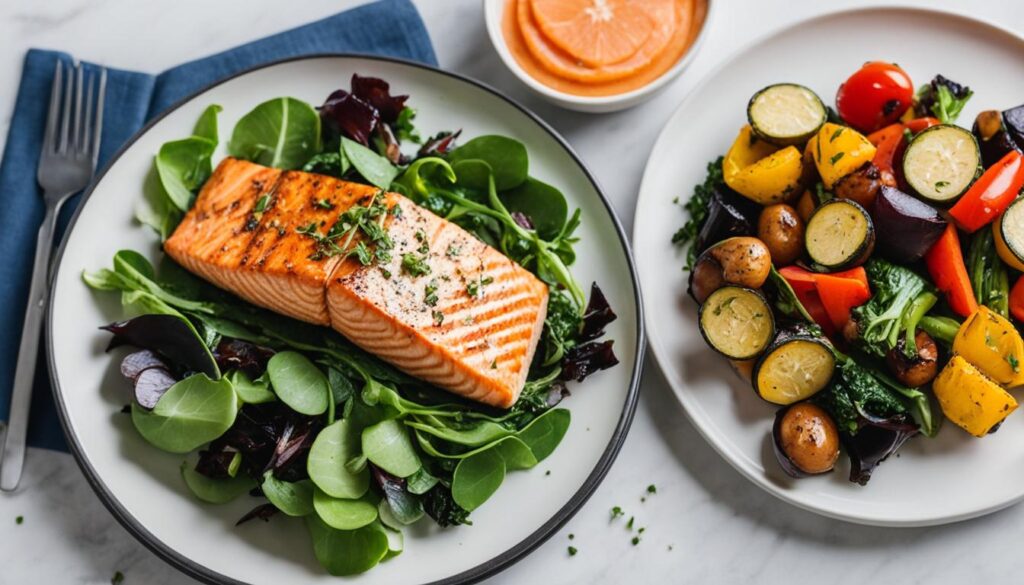
The Mayo Clinic Diet is a comprehensive program designed to help individuals achieve and maintain a healthy weight for life. It emphasizes lifestyle changes, including adopting healthy habits and breaking unhealthy ones. This diet focuses on making simple, sustainable changes that promote weight loss and long-term weight management. By following the Mayo Clinic Diet, you can establish a healthy way of eating, support fat-burning, and improve overall well-being.
The Principles of the Mayo Clinic Diet
The Mayo Clinic Diet is built on key principles that can help you achieve your weight loss goals:
- Healthy eating: The diet encourages the consumption of nutritious, whole foods and discourages processed and unhealthy options.
- Portion control: Learning how to properly portion meals and snacks is essential for weight management.
- Regular physical activity: Incorporating exercise into your daily routine is vital for overall health and weight loss.
- Behavioral changes: The Mayo Clinic Diet emphasizes identifying and breaking unhealthy eating habits while adopting healthier alternatives.
By following these principles, you can create a sustainable lifestyle that supports long-term weight management and healthy habits.
The Two Phases of the Mayo Clinic Diet
The Mayo Clinic Diet is divided into two phases: the Lose It! phase and the Live It! phase.
In the Lose It! phase, which lasts for two weeks, you focus on jump-starting your weight loss by establishing healthy habits and breaking unhealthy ones. This phase is designed to provide quick results and motivation.
In the Live It! phase, you continue to build on the knowledge gained in the Lose It! phase. This phase focuses on long-term weight management by incorporating healthy eating, portion control, regular physical activity, and behavior changes into your everyday life.
Mayo Clinic Diet Meal Plan
Here’s an example of a one-day meal plan that aligns with the Mayo Clinic Diet:
| Meal | Options |
|---|---|
| Breakfast | Vegetable omelet with whole wheat toast |
| Lunch | Turkey and avocado wrap with a side salad |
| Snack | Carrot sticks with hummus |
| Dinner | Grilled chicken breast with roasted vegetables |
| Snack | Greek yogurt with berries |
Remember to incorporate lean proteins, whole grains, fruits, vegetables, and healthy fats into your meals for optimal nutrition.
Key Principles of the Mayo Clinic Diet
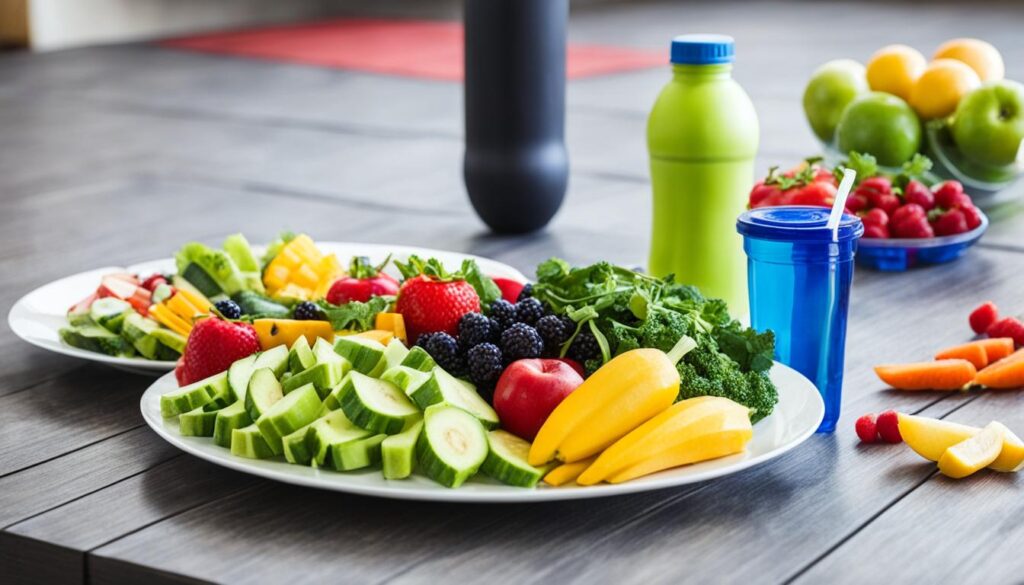
The Mayo Clinic Diet incorporates key principles to promote healthy eating and weight loss. By following these principles, you can make lasting changes to your eating habits and daily routine. These key principles include:
- Managing Portion Sizes: Controlling portion sizes is important for weight management. By being mindful of how much you eat, you can ensure that you are consuming the right amount of calories for your body’s needs. This helps to avoid overeating and supports fat-burning.
- Engaging in Regular Physical Activity: Physical activity is crucial for overall health and weight loss. Incorporating regular exercise into your routine can help boost your metabolism, burn calories, and support fat-burning. Aim for at least 150 minutes of moderate-intensity aerobic activity or 75 minutes of vigorous-intensity aerobic activity per week.
- Adopting Lifelong Habits: The Mayo Clinic Diet promotes the adoption of lifelong habits that support a healthy lifestyle. This includes making sustainable changes to your eating habits, such as choosing nutritious foods and avoiding excessive amounts of added sugars and unhealthy fats. By focusing on long-term behavior changes, you can maintain a healthy weight and support fat-burning in the long run.
Remember, healthy eating, portion control, physical activity, and lifelong habits are key components of the Mayo Clinic Diet. By incorporating these principles into your daily life, you can optimize your weight loss efforts and support a healthy lifestyle.
Stay committed to these key principles and make them a part of your everyday routine. They will help you achieve your weight loss goals and support fat-burning for optimal health and well-being.
The Two Phases of the Mayo Clinic Diet
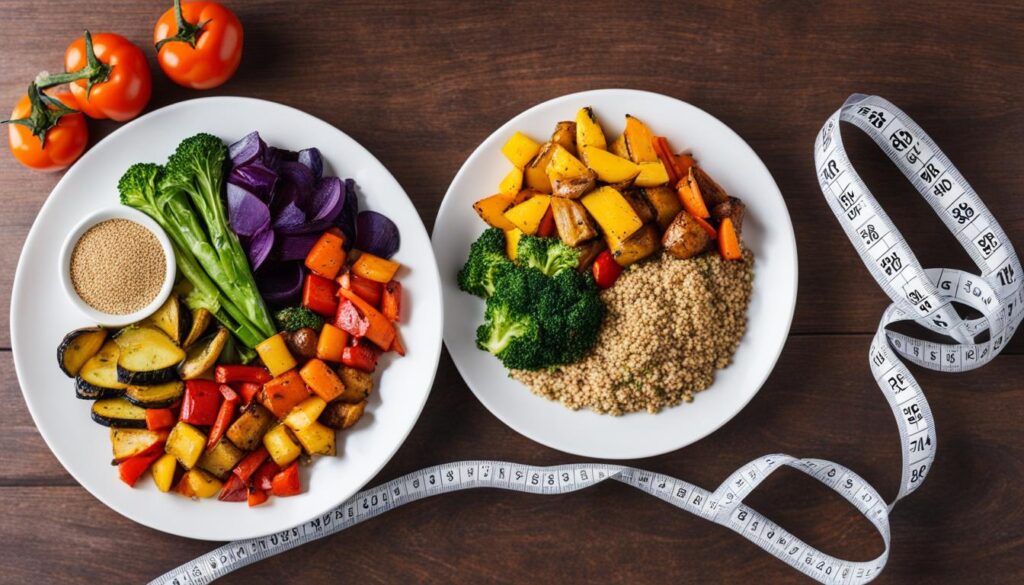
The Mayo Clinic Diet offers a structured approach to weight loss and healthy habits through its two distinct phases: the Lose It! phase and the Live It! phase. Let’s explore each phase in detail and understand how they contribute to achieving sustainable weight loss and promoting healthy habits.
The Lose It! Phase:
The Lose It! phase is designed as a two-week kickstart to your weight loss journey. During this phase, the focus is on establishing healthy habits and breaking unhealthy ones. It aims to create a calorie deficit and jumpstart your metabolism to promote initial weight loss. Through a combination of nutritious meal plans, portion control, and regular physical activity, you can achieve significant progress towards your weight loss goals.
This phase emphasizes the importance of:
- Creating a calorie deficit by reducing overall calorie intake
- Choosing nutrient-dense foods that support weight loss
- Incorporating regular exercise to enhance fat-burning
- Monitoring portion sizes to maintain balance
By following the Lose It! phase diligently, you can expect to experience not only weight loss but also the development of healthy eating and exercise habits that will benefit you in the long term.
The Live It! Phase:
The Live It! phase is the second phase of the Mayo Clinic Diet and focuses on adopting a lifelong approach to health. This phase aims to provide you with the knowledge and tools necessary to sustain your weight loss and maintain a healthy lifestyle throughout your life.
During the Live It! phase, you continue to learn about:
- Optimal food choices that support weight maintenance
- Appropriate portion sizes to prevent overeating
- The importance of regular physical activity for overall health
- Strategies for overcoming challenges and maintaining motivation
By progressing through the Live It! phase, you solidify the healthy habits you developed during the Lose It! phase and integrate them into your daily life. This phase empowers you to make informed food choices, practice portion control, and stay physically active, ensuring long-term weight management and continued fat-burning.
Remember, the Mayo Clinic Diet is not a temporary fix but a lifestyle approach that promotes sustainable weight loss and healthy habits. By embracing both the Lose It! and Live It! phases, you can achieve significant weight loss, establish healthy habits, and support ongoing fat-burning for optimal health and well-being.
Focus on Healthy Food Choices
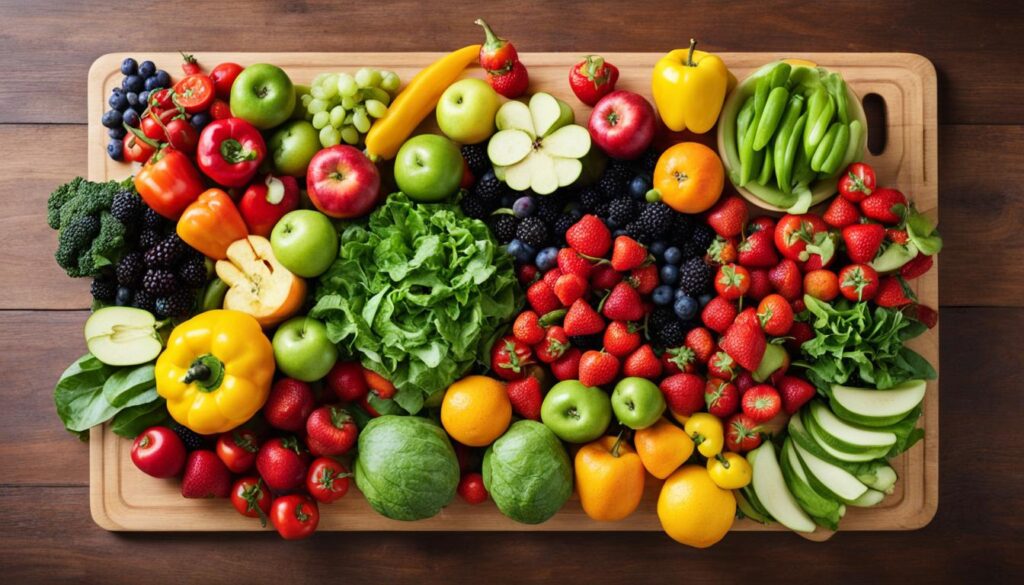
When it comes to optimizing your health and promoting fat-burning, making healthy food choices is essential. The Mayo Clinic Diet encourages a balanced approach to nutrition, focusing on portion sizes and incorporating the Mayo Clinic Healthy Weight Pyramid as a guide to selecting nutritious foods. By emphasizing the consumption of vegetables and fruits, you can fuel your body with essential vitamins, minerals, and antioxidants while keeping your calorie intake in check.
The Mayo Clinic Healthy Weight Pyramid is a visual representation of the types and amounts of foods that should make up a healthy diet. It emphasizes the importance of incorporating generous amounts of vegetables and fruits into your meals, as they are low in calories and high in fiber, which can help you feel full and satisfied. By filling your plate with colorful produce, you can ensure that your meals are nutritionally rich and supportive of your weight loss goals.
“Eating a variety of fruits and vegetables is essential for a healthy diet. They provide essential nutrients and can help reduce the risk of chronic diseases.”
Portion Control
In addition to focusing on healthy food choices, the Mayo Clinic Diet also emphasizes portion control. By understanding appropriate portion sizes, you can ensure that you are consuming the right amount of food to support your weight loss goals. Portion control is about being mindful of the quantity of food you eat and listening to your body’s hunger and fullness cues.
Here are some portion control techniques recommended by the Mayo Clinic:
- Use smaller plates and bowls to control portion sizes.
- Measure and weigh your food to gain a better understanding of appropriate portions.
- Eat slowly and savor each bite to give your body time to register fullness.
- Avoid eating directly from packages or containers, as it can lead to overeating.
By practicing portion control techniques and making thoughtful food choices, you can create a healthy eating pattern that supports fat-burning and weight loss.
Can Women Use the Same Fat-Burning Meal Plans and Workouts as Men?
Yes, women can definitely use the same fatburning workout schedules and meal plans as men. The key is to focus on high-intensity interval training, strength training, and a balanced diet. Women may need to adjust calories and portion sizes based on their individual goals and metabolism, but the principles remain the same.
Increase Physical Activity

In addition to healthy eating, physical activity is a key component of the Mayo Clinic Diet for achieving fat-burning and overall health. Regular exercise not only helps you burn calories but also improves cardiovascular fitness, strengthens your muscles, and enhances your overall well-being. By incorporating a combination of aerobic exercises, such as walking, and resistance exercises, you can maximize your fat-burning potential and support your weight loss goals.
Aerobic Exercise: Walking
One of the most accessible and effective forms of aerobic exercise is walking. It requires no special equipment, can be done anywhere, and is suitable for people of all fitness levels. Walking not only burns calories but also helps increase your metabolism and improve cardiovascular health. Aim for at least 30 minutes of brisk walking every day to reap the benefits of this low-impact exercise.
Resistance Exercises for Fat-Burning
Resistance exercises, also known as strength training, are an essential part of any fat-burning workout routine (see my post here). These exercises involve working against an external resistance, such as weights or resistance bands, to build muscle and increase metabolism. By incorporating resistance exercises into your fitness routine, you can increase lean muscle mass, which in turn supports fat-burning even at rest.
“Resistance exercises are crucial for fat-burning as they help increase muscle mass, which is more metabolically active than fat tissue.”
– Mayo Clinic
Here are some examples of resistance exercises that you can include in your workout regimen:
- Bicep curls
- Squats
- Lunges
- Push-ups
- Planks
Remember to start with weights or resistance bands that are appropriate for your fitness level and gradually increase the intensity as you get stronger.
Incorporating regular physical activity into your daily routine is essential for fat-burning and overall health. Whether it’s going for a brisk walk, hitting the gym for a resistance training session, or participating in a group exercise class, find activities that you enjoy and that fit into your lifestyle. By making physical activity a priority, you can maximize fat-burning, support your weight loss efforts, and improve your overall well-being.
Creating a Sustainable Lifestyle

The Mayo Clinic Diet offers a holistic approach to achieving long-term weight management and optimizing fat-burning potential. By implementing healthy habits, making wise food choices, and staying active, you can establish a sustainable lifestyle that promotes overall well-being. Let’s explore the key elements of creating a sustainable lifestyle for successful weight management.
1. Adopting Healthy Habits
Developing healthy habits is crucial for sustaining long-term weight management. By incorporating positive lifestyle changes into your daily routine, you can establish a strong foundation for maintaining a healthy weight. This includes prioritizing regular exercise, managing stress levels, getting enough sleep, and staying hydrated.
2. Making Smart Food Choices
Eating a nutrient-dense diet is vital for sustainable weight management. Focus on consuming whole foods, such as fruits, vegetables, lean proteins, and whole grains. These foods provide essential nutrients while minimizing the intake of processed and sugary foods. By nourishing your body with wholesome and well-balanced meals, you can support fat-burning and maintain a healthy weight.
3. Staying Active
Physical activity plays a significant role in sustaining weight loss and optimizing fat-burning. Engage in regular exercise that you enjoy, such as walking, cycling, swimming, or participating in fitness classes. Aim for at least 150 minutes of moderate-intensity aerobic activity or 75 minutes of vigorous-intensity aerobic activity per week. Additionally, incorporating strength training exercises can help build muscle, increase metabolism, and enhance overall body composition.
4. Tracking Your Progress
Monitoring your progress is essential for maintaining a sustainable lifestyle and achieving long-term weight management. Keep track of your food intake, exercise routines, and overall well-being. Consider using a journal, an app, or a wearable device to help you stay accountable and motivated. Regularly reviewing your progress can provide insights into your habits and allow for adjustments to ensure ongoing success.
“A sustainable lifestyle is about making conscious choices that nourish your body, mind, and soul, leading to long-term weight management and well-being.” – Mayo Clinic
To illustrate the significance of creating a sustainable lifestyle, here’s a table showcasing the differences between short-term approaches and sustainable habits:
| Short-term Approaches | Sustainable Habits |
|---|---|
| Quick fixes and fad diets | Consistent healthy eating habits |
| Restrictive meal plans | Well-balanced, flexible meal choices |
| Extreme exercise regimens | Regular physical activity that you enjoy |
| Temporary behavior changes | Lifelong commitment to a healthy lifestyle |
By embracing a sustainable lifestyle with healthy habits, you can optimize your weight management journey and support long-term fat-burning. Remember, it’s not just about reaching a specific number on the scale—it’s about prioritizing your overall well-being and establishing habits that will serve you well for years to come.
Conclusion
When it comes to achieving your weight loss goals and optimizing your health, fat-burning meal plans and workouts play a crucial role. By incorporating clean eating, targeted workouts, and a sustainable lifestyle, you can maximize fat-burning potential, improve overall health, and achieve your desired level of well-being.
To start, incorporating clean eating into your daily routine is essential. By choosing nutrient-dense foods and avoiding processed options, you fuel your body with the necessary vitamins and minerals while supporting weight loss. Additionally, engaging in targeted workouts ensures that you burn calories and build lean muscle, enhancing your fat-burning abilities.
Consistency and perseverance are key on this journey to optimal health and weight loss success. By following the strategies outlined in this article, including following fat-burning meal plans, engaging in effective workouts, and adopting a long-lasting sustainable lifestyle, you can achieve your goals and experience the benefits of optimal health and weight loss.
Remember, the road to weight loss and optimal health is a marathon, not a sprint. Stay committed to your fat-burning meal plans and workouts, prioritize your well-being, and enjoy the transformative results on your journey to a healthier, happier you.
Next, we will dive deeper into the significance of nutrition in fat-burning and explore different strategies to enhance your weight loss journey.
Stay tuned for Section 2: The Importance of Nutrition in Fat-Burning.

